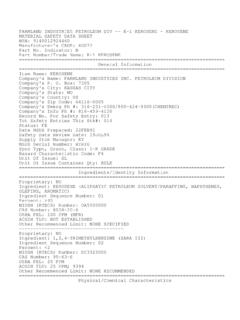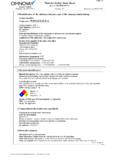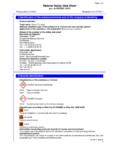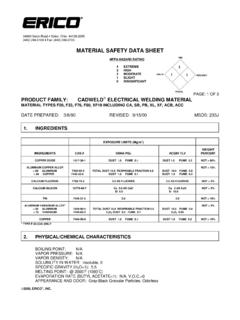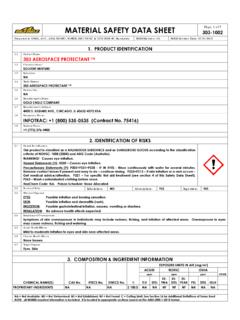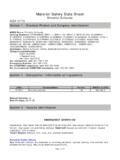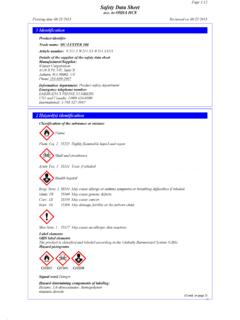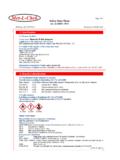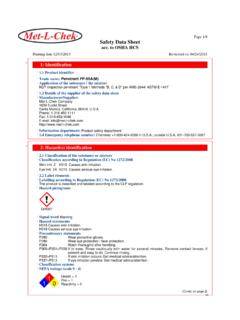Transcription of Material Safety Data Sheet Ethyl Alcohol, 70% …
1 Material Safety data Sheet Ethyl Alcohol, 70%. ACC# 91791. Section 1 - Chemical Product and Company Identification MSDS Name: Ethyl Alcohol, 70%. Catalog Numbers: S75119, S75120, S556CA4. Synonyms: Ethyl Alcohol; Ethyl Hydrate; Ethyl Hydroxide; Fermentation Alcohol; Grain Alcohol; Methylcarbinol;. Molasses Alcohol; Spirits of Wine. Company Identification: Fisher Scientific 1 Reagent Lane Fair Lawn, NJ 07410. For information, call: 201-796-7100. Emergency Number:201-796-7100. For CHEMTREC assistance, call:800-424-9300. For International CHEMTREC assistance, call:703-527-3887. Section 2 - Composition, Information on Ingredients CAS# Chemical Name Percent EINECS/ELINCS.
2 64-17-5 Ethyl alcohol 70 200-578-6. 7732-18-5 Water 30 231-791-2. Hazard Symbols:F. Risk Phrases: 11. Section 3 - Hazards Identification EMERGENCY OVERVIEW. Appearance: colorless clear liquid. Flash Point: deg C. Flammable liquid and cause central nervous system depression. Causes severe eye irritation. Causes respiratory tract irritation. Causes moderate skin irritation. This substance has caused adverse reproductive and fetal effects in humans. Warning! May cause liver, kidney and heart damage. Target Organs: Kidneys, heart, central nervous system, liver. Potential Health Effects Eye: Causes severe eye irritation. May cause painful sensitization to light.
3 May cause chemical conjunctivitis and corneal damage. Skin: Causes moderate skin irritation. May cause cyanosis of the extremities. Ingestion: May cause gastrointestinal irritation with nausea, vomiting and diarrhea. May cause systemic toxicity with acidosis. May cause central nervous system depression, characterized by excitement, followed by headache, dizziness, drowsiness, and nausea. Advanced stages may cause collapse, unconsciousness, coma and possible death due to respiratory failure. Inhalation: Inhalation of high concentrations may cause central nervous system effects characterized by nausea, headache, dizziness, unconsciousness and coma.
4 Causes respiratory tract irritation. May cause narcotic effects in high concentration. Vapors may cause dizziness or suffocation. Chronic: May cause reproductive and fetal effects. Laboratory experiments have resulted in mutagenic effects. Animal studies have reported the development of tumors. Prolonged exposure may cause liver, kidney, and heart damage. Section 4 - First Aid Measures Eyes: Immediately flush eyes with plenty of water for at least 15 minutes, occasionally lifting the upper and lower eyelids. Get medical aid. Gently lift eyelids and flush continuously with water. Skin: Get medical aid. Flush skin with plenty of water for at least 15 minutes while removing contaminated clothing and shoes.
5 Wash clothing before reuse. Flush skin with plenty of soap and water. Ingestion: Do NOT induce vomiting. If victim is conscious and alert, give 2-4 cupfuls of milk or water. Never give anything by mouth to an unconscious person. Get medical aid. Inhalation: Remove from exposure and move to fresh air immediately. If not breathing, give artificial respiration. If breathing is difficult, give oxygen. Get medical aid. Do NOT use mouth-to-mouth resuscitation. breathing is difficult, give oxygen. Get medical aid. Do NOT use mouth-to-mouth resuscitation. Notes to Physician: Treat symptomatically and supportively. Persons with skin or eye disorders or liver, kidney, chronic respiratory diseases, or central and peripheral nervous sytem diseases may be at increased risk from exposure to this substance.
6 Antidote: Replace fluid and electrolytes. Section 5 - Fire Fighting Measures General Information: Containers can build up pressure if exposed to heat and/or fire. As in any fire, wear a self-contained breathing apparatus in pressure-demand, MSHA/NIOSH (approved or equivalent), and full protective gear. Vapors may form an explosive mixture with air. Vapors can travel to a source of ignition and flash back. Will burn if involved in a fire. Flammable Liquid. Can release vapors that form explosive mixtures at temperatures above the flashpoint. Use water spray to keep fire-exposed containers cool. Containers may explode in the heat of a fire.
7 Extinguishing Media: For small fires, use dry chemical, carbon dioxide, water spray or alcohol-resistant foam. For large fires, use water spray, fog, or alcohol-resistant foam. Use water spray to cool fire-exposed containers. Water may be ineffective. Do NOT use straight streams of water. Flash Point: deg C ( deg F). Autoignition Temperature: 363 deg C ( deg F). Explosion Limits, vol %. Upper: vol %. NFPA Rating: (estimated) Health: 2; Flammability: 3; Instability: 0. Section 6 - Accidental Release Measures General Information: Use proper personal protective equipment as indicated in Section 8. Spills/Leaks: Absorb spill with inert Material ( vermiculite, sand or earth), then place in suitable container.
8 Remove all sources of ignition. Use a spark-proof tool. Provide ventilation. A vapor suppressing foam may be used to reduce vapors. Section 7 - Handling and Storage Handling: Wash thoroughly after handling. Use only in a well-ventilated area. Ground and bond containers when transferring Material . Use spark-proof tools and explosion proof equipment. Avoid contact with eyes, skin, and clothing. Empty containers retain product residue, (liquid and/or vapor), and can be dangerous. Keep container tightly closed. Avoid contact with heat, sparks and flame. Avoid ingestion and inhalation. Do not pressurize, cut, weld, braze, solder, drill, grind, or expose empty containers to heat, sparks or open flames.
9 Storage: Keep away from heat, sparks, and flame. Keep away from sources of ignition. Store in a tightly closed container. Keep from contact with oxidizing materials. Store in a cool, dry, well-ventilated area away from incompatible substances. Flammables-area. Do not store near perchlorates, peroxides, chromic acid or nitric acid. Section 8 - Exposure Controls, Personal Protection Engineering Controls:Use explosion-proof ventilation equipment. Facilities storing or utilizing this Material should be equipped with an eyewash facility and a Safety shower. Use adequate general or local exhaust ventilation to keep airborne concentrations below the permissible exposure limits.
10 Exposure Limits Chemical Name ACGIH NIOSH OSHA - Final PELs Ethyl alcohol 1000 ppm TWA 1000 ppm TWA; 1900 mg/m3 TWA 3300 ppm IDLH 1000 ppm TWA; 1900 mg/m3 TWA. Water none listed none listed none listed OSHA Vacated PELs: Ethyl alcohol: 1000 ppm TWA; 1900 mg/m3 TWA Water: No OSHA Vacated PELs are listed for this chemical. Personal Protective Equipment Eyes: Wear appropriate protective eyeglasses or chemical Safety goggles as described by OSHA's eye and face protection regulations in 29 CFR or European Standard EN166. Skin: Wear appropriate protective gloves to prevent skin exposure. Clothing: Wear appropriate protective clothing to prevent skin exposure.
